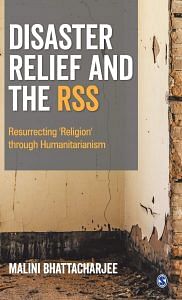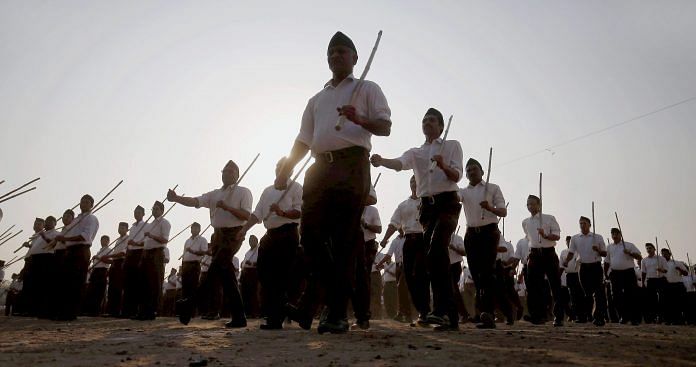Unlike its previous avatars, seva assumed a new formulation under the aegis of the RSS which was formed in 1925. Hedgewar made humble beginnings by deploying swayamsevaks for providing service to Hindus during public festivals and celebrations, especially in those where there was a likelihood of confrontation with the Muslims. As an RSS account reveals:
In 1925, an enquiry committee consisting of Motilal Nehru, Moulana Azad and Dr. Mohamed came to Nagpur to settle the ‘communal issue’. It put forward a mutually agreed formula, as to when and where the music could be played before the mosques and when and where it was to be stopped. But so far as the Muslims were concerned the agreement remained only on paper. They continued to become more and more aggressive. Hindu ladies proceeding for religious festivities like Haritalika became subject to Muslim mischief. However, Doctorji promptly deputed batches of Swayamsevaks to such places and the women devotees could thereafter breathe a sigh of relief. (Deshpande and Ramaswamy [1981] 2015, 88)
The RSS created positive visibility when in 1926 the young swayamsevaks monitored a local celebration of Ram Navami and helped establish orderliness. It was during this occasion that Hedgewar chose a name and a uniform for his new organization: Rashtriya Swayamsevak Sangh, which literally means ‘a national organization of (self-motivated) volunteers’, who wore white shirts, khaki shorts and black khaki caps (Andersen and Damle 1987, 35).1 In doing so, Hedgewar’s purpose was ‘to demonstrate the value of discipline both to the volunteers and to the general public’ (Andersen and Damle 1987): A year later in 1927, when communal riots erupted in Nagpur, another significant act of service by the RSS that attracted the attention of the public was when Anna Sohani, an associate of Hedgewar, organized several swayamsevaks into 16 squads to protect Hindus (Andersen and Damle 1987, 36).
Also read: RSS roadmap for 21st century India — rewrite history, ‘Indianise’ education, museum revamp
Fortifying Seva: Golwalkar
In 1946, just a year before the Partition, several communal riots broke out between the Hindus and the Muslims in Bengal and north-western India. The RSS members emerged as ‘messiahs’ for the Hindus during this time. The Partition of the Indian sub-continent into two countries on religious lines in 1947 and the communal mayhem that followed provided the RSS with a fertile ground for communal mobilization. Under Golwalkar’s leadership, the Sangh played a major role in organizing relief and protection for the Hindu refugees who were fleeing from East and West Pakistan.
During this time, the RSS formed several relief committees across Punjab and Bengal, such as the Hindu Sahayata Samiti, Punjab Relief Committee and the Bastuhara Sahayata Samiti, which distributed food, clothes and blankets in refugee camps to the Hindu refugees and even provided protection to Hindu families from Muslim attacks. This demonstration of ‘dedication, sacrifice and organizational capacity’ during the riots, enabled the RSS to ‘establish its image as the ‘saviour of Hindus’ and helped it to expand its influence in Punjab, Jammu and Kashmir, Delhi and other parts of North India (Kanungo 2003, 55). The rescue operations left several beneficiaries convinced that the RSS was genuinely concerned about the welfare of the Hindus. A large number of these refugees were businessmen who prospered in the new country and who were indebted to the RSS; over a period of time, they became a reliable source of funding for the organization (Andersen and Damle 1987, 49).
This positive image of the RSS however received a severe blow after the assassination of Mahatma Gandhi in 1948 by Nathuram Godse, an ex-member of the Sangh. The RSS was banned by the government of India and several of its leaders were arrested. Consequently, all its public activities came to a standstill. Following a series of negotiations between senior leaders in the RSS such as Eknath Ranade and Golwalkar and Patel and Nehru in the central government, the ban on the RSS was lifted in July 1949, on the condition that the organization adopt a written constitution, maintain transparency in its activities and confine itself only to doing cultural work. The organization therefore maintained a low profile and the rapid expansion of shakha activities that had acquired momentum in refugee camps in northern India was briefly stalled. It was at this stage that Golwalkar ‘reoriented the RSS by playing down its paramilitary past’ and charted out a new form of social involvement for his organization (Beckerlegge 2003, 49). Between 1949 and 1954, the RSS participated in a range of varied social movements such as the bhoodan movement of Vinoba Bhave and the Satyagraha movement to liberate the Portuguese colonies of Dadra and Nagar Haveli while also continuing to offer relief after riots and disasters. After providing refuge to Hindus fleeing from East Pakistan in 1949–1950, in 1950 again, RSS swayamsevaks participated in providing relief after the Assam earthquake.
The situation was worsened by heavy floods in Brahmaputra River and its tributaries like the Dihing River. Many villages were completely washed away and crops were destroyed. The RSS took this opportunity to become actively involved in relief work in the region. The Marwari Relief Society of Calcutta (a close associate of the RSS) sent some workers for relief work. The Assam branch of the RSS organized the Assam Bhukamp Pidit Sahayta Samiti (the Assam earthquake sufferers relief society) and distributed food, clothes and provided shelter to several victims of the earthquake. Naturally, this elicited a lot of popularity from the local people (Madhukar Limaye, Personal Interview June 2006). The organization was also at the forefront of providing humanitarian relief after the Punjab Floods in 1955, the Tamil Nadu cyclone in 1955, the Anjar earthquake in 1956, the Bihar Famine of 1966, the Andhra Cyclone of 1977, the Latur earthquake of 1993 and several other subsequent disasters.
Jaffrelot (1996, 261) suggests that the social welfare strategy of the RSS also helped it find common ground with new political allies. He cites the example of Jayaprakash Narayan joining hands with the RSS in 1967 to collaboratively provide relief to drought victims in Bihar. He explains that one of the reasons for the Hindu nationalists to formally join the JP Movement in 1974 was because both the parties regarded ‘social reform as a priority in comparison with work within the political arena’. The participation of the RSS in these various relief activities brought it in direct contact with a large number of people who were introduced to the concept of Hindu nationalism through either RSS shakha activities, camps or community discussions.
 This excerpt from Disaster Relief and the RSS: Resurrecting ‘Religion’ through Humanitarianism by Malini Bhattacharjee has been published with permission from SAGE Publications India.
This excerpt from Disaster Relief and the RSS: Resurrecting ‘Religion’ through Humanitarianism by Malini Bhattacharjee has been published with permission from SAGE Publications India.




For RSS, it seems our country matters first. For Congress it seems Money matters first.